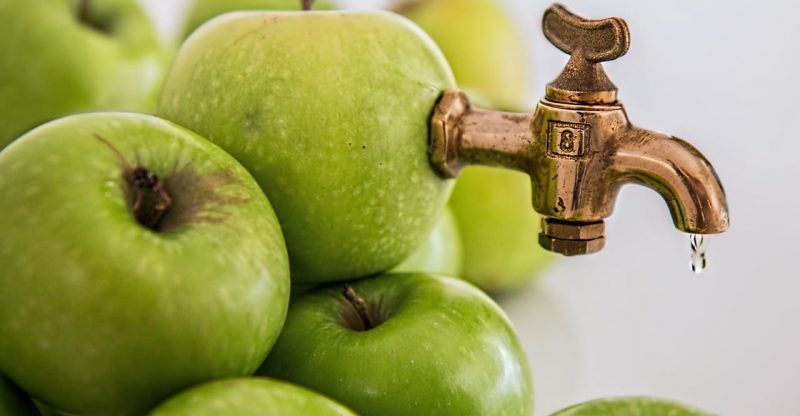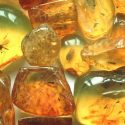What is Malic Acid (E296) in Food? Benefits, Uses, Safety, Side Effects

What is it | Health benefits | Uses | Safety | Side effects | FAQs
Malic acid, commonly associated with apple that naturally presents in fruits enhancing the flavor and sourness. It is used as a flavoring agent and pH control agent in food with the European food additive number E296. This ingredient exists in three forms: D-, L-, and racemic DL-forms (made of equal parts of both forms). Malic acid sold in the market usually refers to its DL form.
What is Malic Acid?
It is a dicarboxylic acid with chemical formula C4H6O5. Its salts and esters are known as malates. Together with another two acidulants, citric acid and fumaric acid, they’re all the key intermediates in the tricarboxylic acid cycle or KREBS cycle in our humans and most living cells.
What are the Natural Sources?
L-Malic acid is naturally present in a lot of fruits with other acidulants such as citric acid, tartaric acid and fumaric acid. L-Malic acid and citric acid are the predominant acids in most fruits.
The following fruits typically contain 0.5-2.0% total acids and rich with it (1):
- Watermelon (99%)
- Apple (95%)
- Apricot (70%)
- Cherry (94%)
- Grape (60%)
- Peach (73%)
- Pear (77%)
Other fruit sources come from grapefruit, lime, lemon, mango, orange, pineapple, strawberry and so on.
How is it made?
The manufacturing processes of malic acid are different based on the types: L, D and DL. Generally, L form is made from carbohydrates fermentation, DL form is synthesized from maleic anhydride and D type is separated from DL form.
1. L-Malic Acid
It occurs naturally in various foods (as mentioned above) and can be produced from fermentation by glucose or other carbohydrates.
2. DL-Malic Acid
It does not occur naturally and according to the FDA, it can be commercially produced by hydration of fumaric acid or maleic acid.
EFSA also mentioned that DL-Malic acid is synthesized by hydration of maleic anhydride (the acid anhydride of maleic acid) under high temperature and pressure to form malic and fumaric acid. (2)
Butane, butene, or benzene from petroleum are the starting materials for the synthesis of maleic anhydride. (3)
3. D-Malic Acid
It does not present naturally and can be manufactured by separating DL-malic acid, the process called chiral resolution.
Specification
| Other Names |
|
| CAS Number |
|
| Chemical formula |
|
| Molecular Weight |
|
| Melting Point |
|
Structure

Properties
Appearance
A white or nearly white crystalline powder or granular with a tart, acidic, lingering taste.
PKa
It is a weak organic acid containing two carboxylic acid functional groups and as a result, it has two PKa values, PKa1 = 3.4 and PKa2 = 5.2.
PH
It has two acidic hydrogens so it would have 2 dissociation equilibrium equations.
How to calculate its PH value (c=0.1mol/L)?
Step 1: Write Charge balance equation
[H+] = [HA-] + 2[A2-] + [OH-]
Then we can get below equation.
![]()
[H+] is the hydronium concentration
[HA−] and [A2−] are conjugate bases concentration
[HA] is the malic acid concentration
Step 2: Estimate the hydronium concentration
Multiply concentration value of malic acid with Ka1,
(c*Ka1)^0.5= 10^-2.2. So we [OH-] can be neglected, along with Ka1*Ka2 in above equation.
Then we obtain

Finally we can get the [H+] and the PH value 2.21.
It is indicated that the its PH value of is 2.21 in the concentration of 100 mM (0.1mol/L). (4)
Solubility
In water
It has high solubility and can dissolve rapidly in water and the solubility increases with temperature. DL-malic acid with the solubility 55.8 g/100g while L-malic acid has the solubility 36.3 g/100g in water at temperature 20°C.
In organic solvents
More soluble in polar solvents than non-polar solvents. Soluble in methanol, diethyl ether, acetone and ethanol. Slightly soluble in ether. Insoluble in benzene. (5)
What are the Health Benefits of Malic Acid?
Malic acid may help our body prevent urinary stones, relieve fibromyalgia, improve dry mouth and do good to our skin.
Urinary stones prevention
According to a study in 2016 that malic acid can be a cheap way to prevent urinary stones. (6)
Fibromyalgia relief
A research in 1995 found that a high level of malic acid is safe and may be beneficial in the treatment of patients with fibromyalgia. (7)
However, a recent study published in Medwave in 2019 reported that the use of magnesium and malic acid makes little or no difference on pain and on depressive symptoms in patients with fibromyalgia. (8)
Dry mouth sensation improvement
A study of 2018 published in Journal of Oral Science, finding that malic acid improves the oral health-related quality of life and dry mouth sensation in patients with xerostomia. (9)
Skin benefits
It functions as an alpha-hydroxy acid (AHA) in skincare products. Following are the benefits of alpha-hydroxy acid to skin (10):
- Make the stratum corneum humid.
- Promote exfoliation of the stratum corneum, enabling the stratum corneum thinner, softer, and improving skin smoothness.
- Increase the firmness and thickness of the epidermis and dermis and improve skin smoothness and reduce wrinkles.
What are the Uses of Malic Acid?
Its food-grade is a widely used ingredient that can control PH, and enhance the flavor in food, also it gives food a tart taste. It acts as a PH buffer when applied in cosmetics.
Food
Flavoring agent
With a tart taste of clean, mellow, smooth and lingering, malic acid is suitable to add together with other acidulants, high-intensity sweeteners, flavors and seasonings.
It provides more natural flavor and intensify the impact of many flavors in foods or beverages, and also improves aftertaste.
Acidulant
It is also commonly added to food for PH adjustment and it can inhibit the growth of some bacterial for preservation.
When used in food, it has below advantages over other organic acids:
- Good solubility and rapid dissolution
- Lower hygroscopicity than citric or tartaric acids
- Lower melting point than other acids
- More sourness at low pH levels
Commonly we can see the following food with it:
- Drinks: soda, beer
- Energy-reduced or with no added sugar confectionery
- Canned or bottled fruit and vegetables
- Jams, jellies and marmalades
- Table-top sweeteners
Cosmetics
Per “European Commission database for information on cosmetic substances and ingredients”, it functions as a buffering agent in cosmetic and personal care products (11). Commonly it can be found in skincare cream and lotion.
Is Malic Acid Safe to Eat?
Yes, its safety used as a food additive has been approved by the U.S. Food and Drug Administration (FDA), European Food Safety Authority (EFSA), Joint FAO/WHO Expert Committee on Food Additives (JECFA), as well as other authorities.
FDA
FDA has approved the application of L and DL malic acid in food, except the baby food, at levels not to exceed good manufacturing practice.
It is generally considered safe (GRAS) and can be used in food as a flavor enhancer, flavoring agent and adjuvant, and pH control agent.
The following are the uses and the maximum level approved by FDA (12):
Food Application |
Maximum uses Level |
| Nonalcoholic beverages | 3.4% |
| Chewing gum | 3.0% |
| Gelatins, puddings, and fillings | 0.8% |
| Hard candy | 6.9% |
| Soft candy | 3.0% |
| Jams and jellies | 2.6% |
| Processed fruits and fruit juices | 3.5% |
| All other food categories | 0.7% |
EFSA
Safety
Malic acid (E296) and its salts, sodium malate (E350), potassium malate (E351) and calcium malate (E352) are authorised food additives in the European Union (EU) for use in a number of foods according to the Commission Regulation (EU) No 1152/2013 of 19 November 2013 amending Annex II to Regulation (EC) N°1333/2008 of the European Parliament and of the Council establishing a Union list of food additives.
Uses
It is classified in “additives other than colours and sweeteners” by the EU and the specific maximum level of E296 is “quantum satis”, which means there is no specific limit in its usage. The following are permitted uses food categories (13):
- Dairy products and analogues
- Fats and oils and fat and oil emulsions
- Edible ices
- Fruit and vegetables
- Confectionery
- Cereals and cereal products
- Bakery wares
- Meat
- Fish and fisheries products
- Eggs and egg products
- Sugars, syrups, honey and table-top sweeteners
- Salts, spices, soups, sauces, salads and protein products
- Foods intended for particular nutritional uses
- Beverages
- Ready-to-eat savouries and snacks
- Desserts
- Food supplements excluding food supplements for infants and young children
- Processed foods excluding foods for infants and young children
There are two conditions pointed out by EFSA:
- It is only the L(+)-form that can be used in processed cereal-based foods and baby foods only for the pH adjustment purpose.
- Malic acid can only be added to pineapple juice with the maximum level 3000 mg/kg instead of to other fruit juices.
UK Food Standards Agency
Categorized in “Others” (14)
Food Standards Australia New Zealand
It is an approved ingredient with the code number 296 in Australia and New Zealand. (15)
JECFA
DL-Malic Acid
Functional class: flavouring agent, acidity regulator. (16)
Acceptable daily intake: ADI “Not Specific” set in 1969, including its sodium, potassium and calcium salts; in the case of D(-)-malic acid and its salts, the ADI is not applicable to very young infants. (17)
L-Malic Acid
Functional class: flavouring agent. (18)
Acceptable daily intake: No safety concern at current levels of intake when used as a flavouring agent. (19)
What are the possible Side Effects?
It is common that sometimes consumers have questions whether malic acid is bad for our health and what are the possible health risks. We understand that consumers prefer natural food additives and have concerns about the synthesized ingredients in the foods we eat.
It is generally considered safe but some people may be allergic or sensitive to it.
Allergy
There were little reports regarding its side effects, but it may trigger some allergy symptoms such as headaches, diarrhea, nausea, and other reactions to people who are allergic to it.
Pregnant and Breastfeeding
Yes, it is generally safe but better consult with your doctor in the condition of use.
Frequently asked questions
Is it Natural?
It depends on the form of malic acid. DL-malic acid is a chemical synthetic one so obviously it is not natural, nor is D-malic acid. L form is natural as it occurs naturally in fruits and commercially made from fermentation.
Is it Vegan?
Yes, as mentioned above, three types are all vegan as the raw material used and manufacturing process without the use of animal matter or products derived from animal origin. As a food ingredient, it is considered vegan and vegetarians can eat the food with it.
Is it Halal?
Yes, it is generally recognised as halal as it is permitted under the Islamic Law and fulfill the conditions of Halal. And we can find some manufacturers certificated with MUI halal.
Is it Kosher?
Yes, it is kosher pareve. E296 has met all the “kashruth” requirements and can be certified as kosher. And may be certificated with passover for some suppliers.
Is it Gluten free?
Yes, it is typically gluten-free and people with celiacs can eat it. The manufacturing process complies with the FDA’s definition of gluten free, that it does not contain wheat, rye, barley, or crossbreeds of these grains.
How much Malic Acid in Apple Juice?
Its content ranges from 0.2%-0.8% according to the apple variety, growing region, fruit maturity and juice extraction process (20). Apple juice can be fermented to make apple cider vinegar.
Why Malic Acid cannot be used in Baby Food by the FDA?
It is not approved for baby food because infants cannot quickly metabolize the D-isomer, which can lead to acidosis.
What is its Role in Wine?
The principal organic acids in grapes are L-tartaric and L-malic acid, accounting for more than 90% of the grape berry’s acid content (21).
The more a grape ripen, the less of its concentration, mostly due to metabolic respiration. The concentration of L-tartaric acid is relatively constant. It is the fluctuating concentration of L-malic acid that usually poses problems to wine makers.
In wine, malic acid functions as a flavoring agent to adjust the taste and a PH control agent which has a profound effect on the microbial stability of wine as it determines the survival and proliferation of bacteria and yeast during and after brewing. The wine will taste flat and will be more susceptible to spoilage if there is not enough malic acid in it.
However, the wine will taste sour if there is too much of it. So the amount of malic acid should be appropriate for the winemaker.
Conclusion
After reading, you may have a well understanding of malic acid (E296), from its three types: L, D and DL; production processes; four health benefits; uses as a flavoring agent and PH control agent; approved safety, possible side effects and some FAQs such as is it vegan, gluten free, synthetic or natural and etc.
What kinds of food packaging have you found this ingredient in? Let me know in the comments.



Wrt malic acid, industrially it is produced from Maleic Anhydride, which itself can either be produced by i) butane and /or ii) benzene. Benzene is widely known to be carcinogenic. To your knowledge, are there legislations that prohibit the use of Malic Acid produced from benzene-based Maleic Anhydride, or it is not regarded to be a concern?
Thanks!